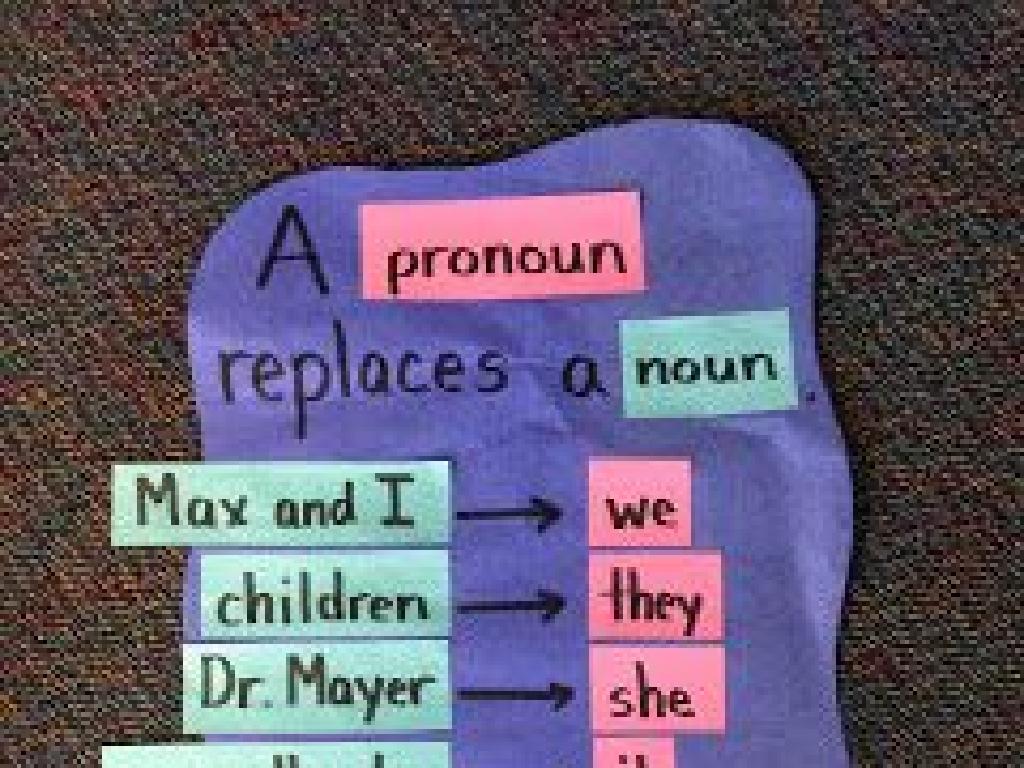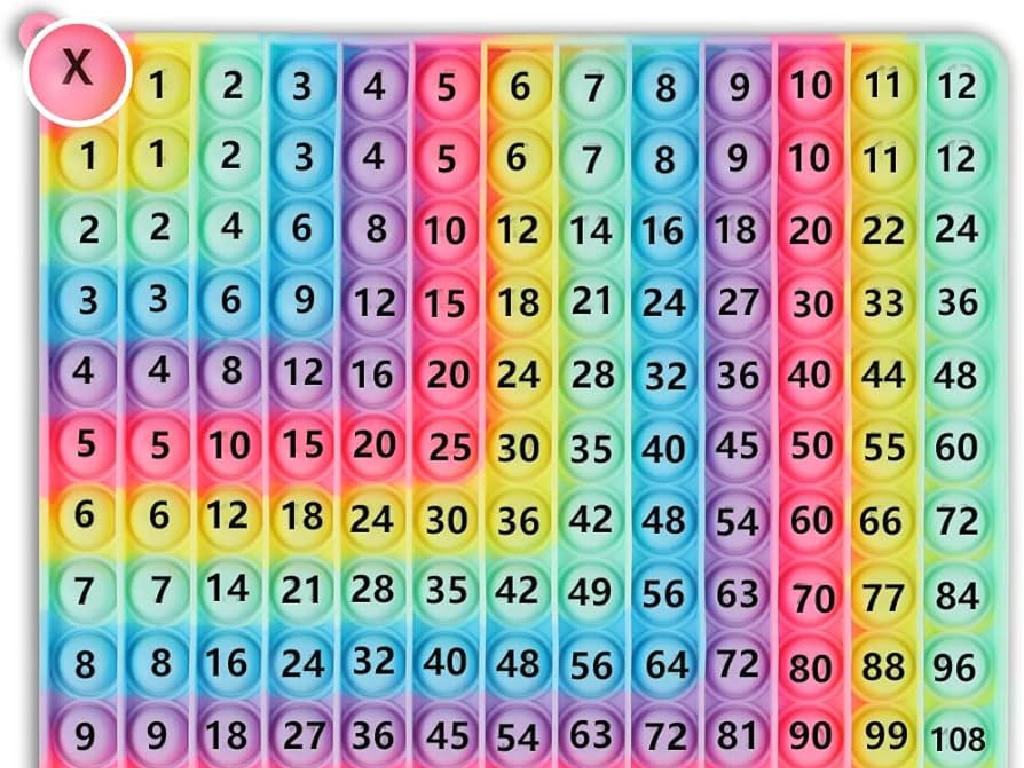Compare Numbers Up To One Million
Subject: Math
Grade: Fourth grade
Topic: Ordering And Comparing
Please LOG IN to download the presentation. Access is available to registered users only.
View More Content
Comparing Numbers Up to One Million
– Learn to compare large numbers
– Importance of ordering in math
– Ordering helps in daily decisions like prices, distances
– How to determine greater or less
– Use symbols >, <, = to compare two numbers
– Practice with real-life examples
– Use examples like population, savings, or distances
|
This slide introduces the concept of comparing and ordering numbers up to one million, which is a fundamental skill in mathematics and a practical tool for everyday life. Emphasize the importance of understanding the value of numbers and their positions. Explain that comparing numbers involves determining which number is larger or smaller using comparison symbols. Provide students with strategies to break down large numbers into more manageable chunks, such as comparing digit by digit from left to right. Incorporate real-life examples where large numbers are used, such as comparing populations of cities, amounts of money saved, or distances between places. Encourage students to think of other examples where they might need to compare large numbers. The goal is for students to feel comfortable with large numbers and to understand their relative values.
Comparing Numbers Up to One Million
– Understanding number comparison
– Symbols: >, ‘ means greater than, ‘ 499,999 and 250,000 < 251,000
– Practice comparing large numbers
– Use symbols to compare numbers like 123,456 and 654,321
|
This slide introduces the concept of comparing numbers, which is a fundamental skill in mathematics. Students will learn to determine the size of numbers relative to each other using comparison symbols. It’s crucial to ensure that students understand what each symbol represents and how to apply them when comparing numbers. Provide examples using large numbers to illustrate the concept clearly. Encourage students to think of real-life situations where they might need to compare numbers, such as comparing distances, prices, or scores. In the next class, we will practice with more examples and students will have the opportunity to demonstrate their understanding by comparing numbers themselves.
Understanding Place Value
– Place value basics
– Each digit has a value based on its place
– Value depends on position
– A digit can mean tens, hundreds, or more
– Review place values to 1 million
– Ones, tens, hundreds, thousands, ten-thousands, hundred-thousands
– Practice comparing numbers
– Use place value to determine which is greater
|
Begin with a refresher on the concept of place value, as it’s crucial for comparing numbers effectively. Explain that the value of each digit in a number is determined by its position within that number. For example, in the number 5,432, the ‘5’ is in the thousand’s place and represents 5,000. Review the place values up to one million, ensuring students are comfortable with ones through hundred-thousands. Engage the class with examples, asking them to identify the place value of digits in various numbers. Conclude with an activity where students practice comparing numbers using place value, reinforcing their understanding of how to determine which numbers are greater or smaller.
Comparing Numbers Up to One Million
– Start with the highest place value
– Look at the digits in the leftmost place first
– Same digits? Move right
– If the first digits match, compare the next place value
– Continue until different digits
– Find the first place where digits differ to compare
– Determine which number is greater
– Use the different digits to decide which is larger
|
When teaching students to compare large numbers, it’s crucial to start with the highest place value, which is the leftmost digit, and work our way to the right. If the digits are the same, we move one place value to the right and compare again. This process continues until we find digits that are different. At that point, we can determine which number is greater based on which has the larger digit in the highest place value where they differ. For example, when comparing 450,000 and 389,000, we see that the first digit (4) is greater than the third digit (3), so 450,000 is the larger number. This methodical approach helps students understand the value of each digit based on its position and reinforces the concept of place value.
Let’s Practice Comparing Numbers!
– Comparing large numbers together
– Use place value for comparison
– Look at the digits from left to right to decide which is larger
– Correct use of comparison symbols
– Symbols: > (greater than), < (less than), = (equal to)
– Activity: Compare with a partner
– Share your findings and explain your reasoning
|
This slide is designed to engage students in a practical activity to compare numbers up to one million. Encourage them to use their understanding of place value, starting from the highest (leftmost) digit and moving to the right, to determine which number is greater. Remind them of the importance of using comparison symbols correctly. For the activity, pair students up and have them compare a set of numbers, ensuring they articulate their thought process. As a teacher, prepare to circulate the room to assist and challenge students with different sets of numbers. Offer praise for correct usage of symbols and correct reasoning.
Comparing Numbers with the Same Digits
– Numbers with same digits can differ
– Digit position affects value
– For example, 123 and 321 have same digits but different values.
– Comparing numbers with same digits
– Which is greater: 562 or 265? Look at the highest place value first.
– Practice to understand value
– Try comparing 734 and 347 to see how position changes value.
|
This slide introduces the concept that numbers with the same digits can have different values depending on the order of the digits. Emphasize the importance of place value in determining the size of a number. Provide examples where students can visually see how the position of a digit within a number can change its value. During practice, guide students to compare numbers by starting with the highest place value (e.g., compare hundreds before tens). Encourage them to explain their reasoning for which number is greater. This will help solidify their understanding of place value and its role in comparing numbers.
Comparing Numbers on a Number Line
– Visualize with a number line
– A number line helps us see the order of numbers clearly.
– Right side means greater
– Remember: as you move right, numbers increase.
– Left side means smaller
– Moving left on the number line, numbers decrease.
– Practice by placing numbers
– Let s try 23,456 and 123,456 – which is greater?
|
This slide introduces the concept of using a number line to compare numbers up to one million. Emphasize to students that the number line is a powerful tool for visualizing and understanding the relative size of numbers. Explain that numbers increase as we move to the right and decrease as we move to the left. Use examples to show how to place numbers on the number line and compare their values. Encourage students to think of the number line as a horizontal ‘ladder’ where each step to the right goes up in value. For the activity, have students practice by placing given numbers on a number line and determining which are greater or smaller.
Class Activity: Number Comparison Challenge
– Compare numbers up to 1 million
– Order numbers with a partner
– Arrange a set of numbers from smallest to largest
– Use comparison symbols
– Symbols: , =
– Show greater or lesser numbers
– For example, is 560,000 > 359,999?
|
This activity is designed to help students understand the concept of comparing and ordering large numbers. Students will pair up and receive a set of numbers that they will need to arrange from the smallest to the largest. They will use comparison symbols to indicate which numbers are greater or less than the others. Teachers should prepare sets of numbers in advance, ensuring that they are all under one million. Possible variations of the activity could include using number cards, a competitive game where pairs race to order numbers correctly, or a collaborative class effort to order a large set of numbers as a group. The goal is to reinforce the understanding of place value and the ability to compare large numbers effectively.
Conclusion: Mastering Number Comparison
– Congratulations on your hard work!
– Recall the comparison steps
– Remember to line up numbers by place value
– Use , and = correctly
– These symbols show if one number is less than, greater than, or equal to another
– Keep practicing with big numbers
– Try comparing numbers daily to sharpen your skills
|
As we wrap up today’s lesson on comparing numbers up to one million, it’s important to acknowledge the students’ effort and progress. Reinforce the steps for comparing numbers, such as lining up digits by place value and checking from the largest place value down. Remind them to use comparison symbols correctly, and emphasize the importance of consistent practice to become more confident in their ability to compare large numbers. For homework, assign a few comparison problems and encourage students to create their own number comparisons with peers or family members to continue practicing.






